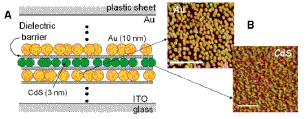Chemical and Biomolecular Research Papers -- Faculty Authors Series

Ravi Saraf Publications
Document Type
Article
Date of this Version
2002
Abstract
Microarray technology is playing an increasingly important role in biology and medicine and its application to genomics for gene expression analysis has already reached the market with a variety of commercially available instruments. In these combinatorial analysis methods, known probe single-strand DNA (ssDNA) “primers” are attached in clusters of typically 100 μm × 100 μm pixels. Each pixel of the array has a slightly different sequence. On exposure to “unknown” target ssDNA, the pixels with the right complementary probe ssDNA sequence convert to double-stranded DNA (dsDNA) by a hybridization reaction. To transduct the conversion of the pixel to dsDNA, the target ssDNA is labeled with a photoluminescent tag during the polymerase chain reaction (PCR) amplification process. Due to the statistical distribution of the tags in the target ssDNA, it becomes significantly difficult to implement these methods as a diagnostic tool in a pathology laboratory. A method to sequence DNA without tagging the molecule is developed. The fabrication process is compatible with current microelectronics and (emerging) soft-material fabrication technologies, allowing the method to be integrable with microelectromechanical systems (MEMS) and lab-on-a-chip devices. An estimated sensitivity of 10-12 g on a 1 cm2 device area is obtained.


Comments
Published in Smart Materials and Structures 11 (2002), pp. 778–782. Copyright © 2002 IOP Publishing Ltd. Used by permission. http://stacks.iop.org/SMS/11/778